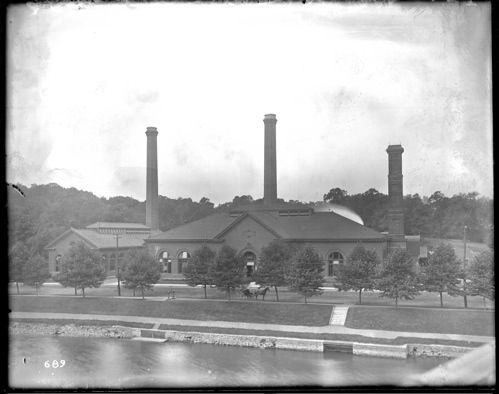
Belmont Pumping Station, 1899-1900
West River Drive at Montgomery Drive, Philadelphia PA
© Jane Mork Gibson,
Workshop of the
World (Oliver Evans Press, 1990).
The City of Philadelphia
maintains two pumping stations that draw water from the
Schuylkill River—Belmont (1870) and Queen Lane
(1895)—both of which are connected to filtration
and water purification facilities. The filtration beds
installed and the increased capacity of these stations
and of those on the Delaware River enabled the city to
shut down three earlier pumping stations on the
Schuylkill: Fairmount (1812-1911), Spring Garden
(1844-1909), and Roxborough (1869-1962).
Protecting the purity of the city water supply was a
major reason for the creation of Fairmount Park, and this
action made possible the selection of the site for the
Belmont Pumping Station in 1870, with the elimination of
polluting industries on the west river bank immediately
upstream—namely, Belmont Petroleum Refinery and the
Simpson Calico Print and Dye Works (Washington Print
Works).
The 1870 structure was replaced in 1899-1900 by the
extant red brick Victorian Pump House. Originally the
power was supplied by steam engines, with a separate
boiler house in the rear. In the 1920s the steam
engines were replaced with electric motors and the boiler
house has since been taken down. The combination of
alternating current power for the pumps and direct
current power for the valves require appropriate
switchgear equipment. To control the valves in an
emergency, a group of storage batteries is maintained as
a back-up.
There are five centrifugal pumps (1960s and 1981) which
have a total capacity of 170 million gallons per day
(mgd)—two at 40 mgd and three at 30 mgd. The
station is unmanned, but the intakes at the river are
manually raked to clear debris. The two intakes are made
of brick and are approximately 6 feet diameter. Two
48-inch diameter mains, 8,880 feet each, carry the water
to the Belmont Treatment Plant located on Belmont and
City Line Avenue. 1
1 Telephone interview
with Drew Brown.
Update May
2007 (by
Jane Mork Gibson):
There has been little change at the Belmont Pumping
Station since 1990. Water taken from the Schuylkill at
this location is pumped to the large sedimentation
reservoir and filtration plant on City Line Avenue, where
there is an additional high service facility. In 1870, a
large cast iron pipe was laid across the bottom of the
Schuylkill River so that water pumped at Belmont could
supply eastern parts of the city via an extensive layout
of pipes and reservoirs. Today the distribution system is
arranged so that the pumping stations and reservoirs are
all interconnected, with links that enable water to be
channeled to any area in the city.